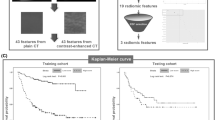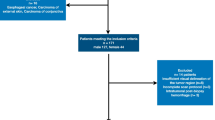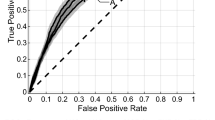Abstract
Background and purpose
Current prognostic models for soft tissue sarcoma (STS) patients are solely based on staging information. Treatment-related data have not been included to date. Including such information, however, could help to improve these models.
Materials and methods
A single-center retrospective cohort of 136 STS patients treated with radiotherapy (RT) was analyzed for patients’ characteristics, staging information, and treatment-related data. Therapeutic imaging studies and pathology reports of neoadjuvantly treated patients were analyzed for signs of response. Random forest machine learning-based models were used to predict patients’ death and disease progression at 2 years. Pre-treatment and treatment models were compared.
Results
The prognostic models achieved high performances. Using treatment features improved the overall performance for all three classification types: prediction of death, and of local and systemic progression (area under the receiver operatoring characteristic curve (AUC) of 0.87, 0.88, and 0.84, respectively). Overall, RT-related features, such as the planning target volume and total dose, had preeminent importance for prognostic performance. Therapy response features were selected for prediction of disease progression.
Conclusions
A machine learning-based prognostic model combining known prognostic factors with treatment- and response-related information showed high accuracy for individualized risk assessment. This model could be used for adjustments of follow-up procedures.
Zusammenfassung
Hintergrund und Zielsetzung
Aktuelle prognostische Modelle für Patienten mit Weichteilsarkomen basieren primär auf Staginginformationen. Therapieinformationen werden dabei nicht berücksichtigt. Die Berücksichtigung solcher Daten könnte die Vorhersage verbessern.
Material und Methoden
Für eine retrospektive, monozentrische, strahlentherapeutisch behandelte Kohorte mit 136 Weichteilsarkompatienten wurden Patientencharakteristika, Staging und therapieassoziierte Daten erhoben. Potenzielle mit dem Therapieansprechen assoziierte Informationen von neoadjuvant behandelten Patienten wurden aus therapeutischen Magnetresonanztomographie(MRT)-Datensätzen und pathologischen Befunden erhoben. Auf Basis dieser Informationen wurden Random-Forest-Modelle für die Vorhersage des 2‑Jahres-Überlebens bzw. des Progresses generiert. Prätherapie- und Therapiemodelle wurden verglichen.
Ergebnisse
Die prognostischen Modelle zeigten insgesamt eine gute Vorhersagekraft. Die Hinzunahme von Therapieinformationen konnte die Vorhersageeffizienz der 3 Klassifikationen verbessern: Vorhersage des Versterbens sowie des lokalen und systemischen Progresses („area under the receiver operating or characteristic curve“ [AUC] je 0,87, 0,88 und 0,84). Strahlentherapieassoziierte Informationen wie das Planungszielvolumen und die Gesamtdosis hatten einen großen Einfluss auf die Vorhersagekraft. Mit dem Therapieansprechen assoziierte Informationen wurden für die Vorhersage des Progresses selektiert und zeigten so eine mögliche prognostische Bedeutung.
Schlussfolgerung
Auf maschinellem Lernen basierende prognostische Modelle zeigten eine hohe Genauigkeit für die Vorhersage des Überlebens und Krankheitsprogresses durch Einschluss von Informationen zur Therapie und zum Therapieansprechen. Diese Modelle könnten für die individuelle Risikoabschätzung in der Nachsorge verwendet werden.




Similar content being viewed by others
References
Gutierrez JC, Perez EA, Franceschi D et al (2007) Outcomes for soft-tissue sarcoma in 8249 cases from a Large State Cancer Registry. J Surg Res 141:105–114. https://doi.org/10.1016/j.jss.2007.02.026
Zagars GK, Ballo MT, Pisters PWT et al (2003) Prognostic factors for patients with localized soft-tissue sarcoma treated with conservation surgery and radiation therapy: an analysis of 1225 patients. Cancer 97:2530–2543. https://doi.org/10.1002/cncr.11365
Pisters PW, Leung DH, Woodruff J, Shi W, Brennan MF (1996) Analysis of prognostic factors in 1,041 patients with localized soft tissue sarcomas of the extremities. J Clin Oncol 14:1679–1689. https://doi.org/10.1200/JCO.1996.14.5.1679
Ramanathan RC, A’Hern R, Fisher C, Thomas JM (1999) Modified staging system for extremity soft tissue sarcomas. Ann Surg Oncol 6:57–69
Maki RG, Moraco N, Antonescu CR et al (2013) Toward better soft tissue sarcoma staging: building on american joint committee on cancer staging systems versions 6 and 7. Ann Surg Oncol 20:3377–3383. https://doi.org/10.1245/s10434-013-3052-0
Suit HD, Mankin HJ, Wood WC et al (1988) Treatment of the patient with stage M0 soft tissue sarcoma. J Clin Oncol 6:854–862. https://doi.org/10.1200/JCO.1988.6.5.854
Edge SB, Compton CC (2010) The American Joint Committee on Cancer: the 7th edition of the AJCC cancer staging manual and the future of TNM. Ann Surg Oncol 17:1471–1474. https://doi.org/10.1245/s10434-010-0985-4
Andrä C, Klein A, Dürr HR et al (2017) External-beam radiation therapy combined with limb-sparing surgery in elderly patients (>70 years) with primary soft tissue sarcomas of the extremities. Strahlenther Onkol 193:604–611. https://doi.org/10.1007/s00066-017-1109-x
Kattan MW, Leung DHY, Brennan MF (2002) Postoperative nomogram for 12-year sarcoma-specific death. J Clin Oncol 20:791–796. https://doi.org/10.1200/JCO.2002.20.3.791
Eilber FC, Brennan MF, Eilber FR et al (2004) Validation of the postoperative nomogram for 12-year sarcoma-specific mortality. Cancer 101:2270–2275. https://doi.org/10.1002/cncr.20570
Amin MB, Edge S, Greene F et al (eds) (2017) AJCC cancer staging manual, 8th edn. Springer, Cham
Tufman A, Kahnert K, Kauffmann-Guerrero D et al (2017) Clinical relevance of the M1b and M1c descriptors from the proposed TNM 8 classification of lung cancer. Strahlenther Onkol 193:392–401. https://doi.org/10.1007/s00066-017-1118-9
Abernethy AP, Etheredge LM, Ganz PA et al (2010) Rapid-learning system for cancer care. J Clin Oncol 28:4268–4274. https://doi.org/10.1200/JCO.2010.28.5478
Lambin P, van Stiphout RGPM, Starmans MHW et al (2013) Predicting outcomes in radiation oncology–multifactorial decision support systems. Nat Rev Clin Oncol 10:27–40. https://doi.org/10.1038/nrclinonc.2012.196
Wardelmann E, Haas RL, Bovée JVMG et al (2016) Evaluation of response after neoadjuvant treatment in soft tissue sarcomas; the European Organization for Research and Treatment of Cancer-Soft Tissue and Bone Sarcoma Group (EORTC-STBSG) recommendations for pathological examination and reporting. Eur J Cancer 53(021):84–95. https://doi.org/10.1016/j.ejca.2015.09.021
Breiman L (2001) Random forests. Mach Learn 45(1):5–32. https://doi.org/10.1023/A:1010933404324
Zimmer VA, Glocker B, Hahner N et al (2017) Learning and combining image neighborhoods using random forests for neonatal brain disease classification. Med Image Anal 42:189–199. https://doi.org/10.1016/j.media.2017.08.004
Chen T, Cao Y, Zhang Y et al (2013) Random forest in clinical metabolomics for phenotypic discrimination and biomarker selection. Evid Based Complement Alternat Med. https://doi.org/10.1155/2013/298183
Liu M, Xu X, Tao Y, Wang X (2017) An improved random forest method based on RELIEFF for medical diagnosis. IEEE International Conference on Computational Science and Engineering (CSE) and IEEE International Conference on Embedded and Ubiquitous Computing (EUC), pp 44–49
Kotti M, Duffell LD, Faisal AA, McGregor AH (2017) Detecting knee osteoarthritis and its discriminating parameters using random forests. Med Eng Phys 43:19–29. https://doi.org/10.1016/j.medengphy.2017.02.004
Rastgoo M, Lemaître G, More O et al (2016) Classification of melanoma lesions using sparse coded features and random forests. Proceedings Volume 9785, Medical Imaging 2016: Computer-Aided Diagnosis; 97850 C. https://doi.org/10.1117/12.2216973
Statnikov A, Aliferis CF, Tsamardinos I, Hardin D, Levy S (2005) A comprehensive evaluation of multicategory classification methods for microarray gene expression cancer diagnosis. Bioinformatics 21:631–643. https://doi.org/10.1093/bioinformatics/bti033
Eibe F, Hal MA, Ian H (2016) Witten the WEKA workbench. Online appendix for “data mining: practical machine learning tools and techniques”. Morgan Kaufmann, Burlington.
Vallières M, Freeman CR, Skamene SR, El Naqa I (2015) A radiomics model from joint FDG-PET and MRI texture features for the prediction of lung metastases in soft-tissue sarcomas of the extremities. Phys Med Biol 60:5471–5496. https://doi.org/10.1088/0031-9155/60/14/5471
Abeshouse A, Adebamowo C, Adebamowo SN, Akbani R, Akeredolu T, Ally A et al (2017) Comprehensive and integrated genomic characterization of adult soft tissue sarcomas. Cell 171(8):950–965.e2. https://doi.org/10.1016/j.cell.2017.10.014
Sica GT (2006) Bias in research studies. Radiology 238:780–789. https://doi.org/10.1148/radiol.2383041109
Wulfkuhle JD, Liotta LA, Petricoin EF (2003) Proteomic applications for the early detection of cancer. Nat Rev Cancer 3:267–275. https://doi.org/10.1038/nrc1043
Meyerson M, Gabriel S, Getz G (2010) Advances in understanding cancer genomes through second-generation sequencing. Nat Rev Genet 11:685–696. https://doi.org/10.1038/nrg2841
Vallieres M, Kumar A, Sultanem K, El Naqa I (2013) FDG-PET image-derived features can determine HPV status in head-and-neck cancer. Int J Radiat Oncol Biol Phys 87:467. https://doi.org/10.1016/j.ijrobp.2013.06.1236
Deist TM, Jochems A, van Soest J et al (2017) Infrastructure and distributed learning methodology for privacy-preserving multi-centric rapid learning health care: euroCAT. Clin Transl Radiat Oncol 4:24–31. https://doi.org/10.1016/j.ctro.2016.12.004
Peeken JC, Nüsslin F, Combs SE (2017) Radio-oncomics. Strahlenther Onkol. https://doi.org/10.1007/s00066-017-1175-0
Wichmann H, Güttler A, Bache M et al (2014) Inverse prognostic impact of ErbB2 mRNA and protein expression level in tumors of soft tissue sarcoma patients. Strahlenther Onkol 190:912–918. https://doi.org/10.1007/s00066-014-0655-8
Funding
Deutsches Konsortium für Translationale Krebsforschung (DKTK), Partner Site Munich (to JP, KK, SC), Alexander von Humboldt Foundation through German Federal Ministry for Education and Research, and the Bavarian Competence Network for Technical and Scientific High Performance Computing (to MB and BR), Allianz (to TG, BK, PT and AB).
Author information
Authors and Affiliations
Corresponding author
Ethics declarations
Conflict of interest
J.C. Peeken, T. Goldberg, C. Knie, B. Komboz, M. Bernhofer, F. Pasa, K.A. Kessel, P.D. Tafti, B. Rost, F. Nüsslin, A.E. Braun, and S.E. Combs declare that they have no competing interests.
Ethical standards
All procedures performed in studies involving human participants were in accordance with the ethical standards of the institutional and/or national research committee and with the 1964 Helsinki declaration and its later amendments or comparable ethical standards. Informed consent was obtained from all individual participants included in the study.
Additional information
Both authors contributed equally: Jan C. Peeken, Tatyana Goldberg.
Caption Electronic Supplementary Material
66_2018_1294_MOESM1_ESM.docx
Supplemental Tables and Supplemental Figure. Table S1: Performance assessment of six random forest-based prediction models. Table S2: Comparison of AUC values on training and test sets of six random forest-based prediction models. Figure S1: Precision/Recall curves for the spectrum of reliability scores for the pre-treatment models.
Rights and permissions
About this article
Cite this article
Peeken, J.C., Goldberg, T., Knie, C. et al. Treatment-related features improve machine learning prediction of prognosis in soft tissue sarcoma patients. Strahlenther Onkol 194, 824–834 (2018). https://doi.org/10.1007/s00066-018-1294-2
Received:
Accepted:
Published:
Issue Date:
DOI: https://doi.org/10.1007/s00066-018-1294-2




